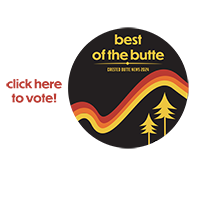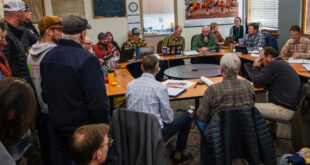Public art stipend with public projects
By Mark Reaman
The Crested Butte Creative District is preparing for the future and life after its three-year, $75,000 grant from the state’s Colorado Creative Industries expires.
The Creative District Commission got the thumbs-up from the Crested Butte Town Council on Monday, March 20 to expand the board from seven to nine people, along with a strong indication that the town will continue to financially support the district’s efforts as it moves toward “self-sufficiency.” Part of that effort will be the town adopting an Art in Public Places policy.
In an hour-long work session with the Town Council, members of the Creative Commission updated the council on its progress and the importance of art in a community. They pointed out there are economic as well as social benefits to a community. “In Gunnison County, creative industries drive $6.9 million in economic activity annually, based on 2012 studies,” reported commission member Shaun Horne.
“One purpose of the district is to attract artists to a community and create hubs of economic activity,” said commission chair Melissa Mason. “Artists don’t have to work just in the mapped district. Anyone in the area can register as a creative with the district.”
The formal Creative District is a U-shaped section of town that includes primarily Elk Avenue, the Center for the Arts and Belleview Avenue.
“The creation of this district has already helped with communication and coordination among arts organizations in the valley,” said Mason. “It has been helpful supporting local creatives. We want to put ourselves on the map as a cultural destination.”
Commission member Kimbre Woods said the organization’s website is being updated and includes a comprehensive directory of creatives in the area. A centralized events calendar is in the works.
“It has been really good to see the Tourism Association come to the table and help us by supporting marketing of the district,” added town planner and Creative District architect Michael Yerman. “It is good to see they appreciate the cultural resources of the community as well as the trails and outdoor opportunities we have here.”
The commission has drafted a preliminary outline of how to move to self-sufficiency once the state grant runs out. “In the meantime, we will be looking for some assistance,” explained Horne. “We hope the council can give us basic funding as we move toward self-sufficiency. We understand that being self sufficient is important.”
Yerman said the hope was to get private donors to appreciate and fund the district’s work. He estimated that could take two or three years to cultivate. “The commission will always be a town board but there will be costs in the transition to self-sufficiency,” Yerman said.
“With the commission under the town it makes sense to have town support,” said Mason. “It is such a huge economic driver. We are looking for the town to step up and support it with dollars as well.”
“It’s not particularly expensive but there are some costs,” added Horne. “It is a fairly efficient district that doesn’t use a lot of money but provides good services.”
Mayor Glenn Michel and the rest of the council appeared supportive and asked the staff to include the costs during the next budget evaluation.
As for the Arts in Public Places policy, the commission is compiling a policy that details how art in public places is selected and maintained. The commission will review and recommend public art projects that the council will ultimately approve.
Yerman told the council the goal is to include a 2 percent art stipend as part of any major public project within the district or at a town park. He used this summer’s upgrade to the Four-way Stop bus center as an example where art would be part of the end product. That project is estimated to cost $400,000, so an $8,000 art line item would be part of the project.
The commission received an overall show of support from the council with their update and requests. The council will look at a budget allocation for the commission this fall.
 The Crested Butte News Serving the Gunnison Valley since 1999
The Crested Butte News Serving the Gunnison Valley since 1999


